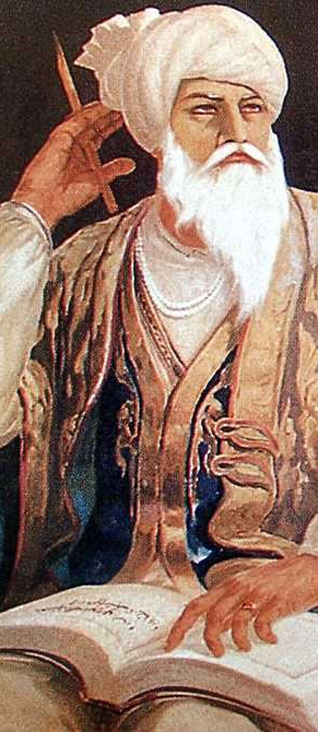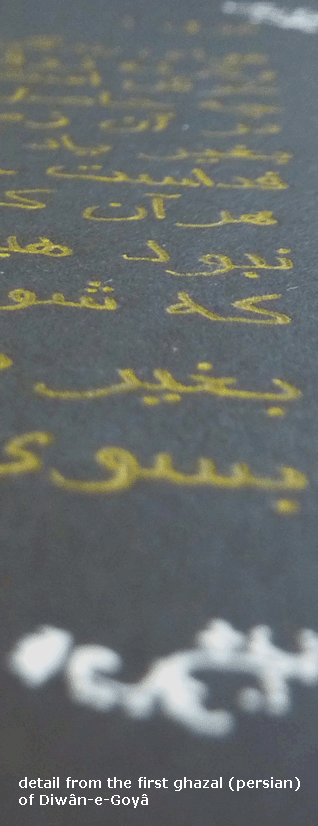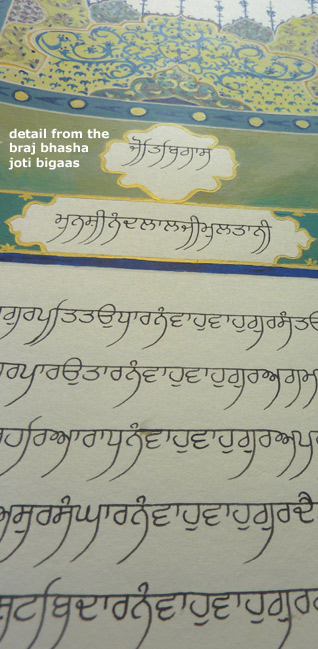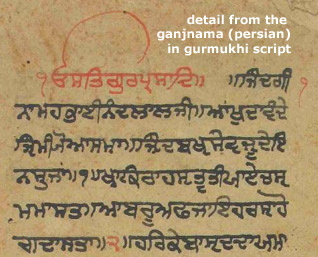Our Heroes
Poet Laureate of The Court of Guru Gobind Singh:
Bhai Nand Lal Goya
TURIYA
It is widely known that Guru Gobind Singh’s court was adorned with 52 scholar-poets for the sake of composing poetry and translating the ancient wisdom of the known world from extinct languages to the common vernacular.
Little, however, is known of the magnitude and extent of the activities of those poets.
A new website, www.bhainandlal.com, launched this week tries to provide a rare insight into the darbâr of the Tenth Master.
Bhai Mani Singh, Bhai Daya Singh and Bhai Nand Lal are names familiar to most Sikhs. However, lesser known about these extraordinary Sikhs is that they were part of a larger entourage of more than 50 scholar-poets working in the flourishing Sikh cities of Paonta and Anandpur.
Under the Tenth Guru’s patronage, ancient works of legend, myth and religious lore … such as the Vedas, Upanishads, Kimia-e-Sadat, Chanakya Rajniti and the monumental Mahabharat, were translated and commented upon in the many workshops of Anandpur.
The scholarly activities at Anandpur culminated in the voluminous Vidya Sagar Granth which is said to have weighed more than 320 kilos and included works of history, hagiography, philosophy, mysticism, polity, linguistics, mythology, eulogy, tales of love and sacrifice, manuals of writing poetry and prose, manuals of government and nation building, manuals of logic and rhetorics, manuals of ethics and morals, dictionaries and discussion of language and linguistics, and much more.
THE SHINING STAR
Amongst these 52 scholar-poets, Bhai Nand Lal Goya stood out as the darbar’s most shining star.
He was born in Ghazni, Afghanistan, where he spent most of his childhood years. During his formative years, his father engaged him in classical Islamic learning which encompassed a deep study of the Persian and Arabic languages as well as a comprehensive schooling in the Qur’an, Hadîths and works on mysticism such as Hujwirî’sKashfu’l- Mahjûb and Rumi’s Mathnavi-ye Ma’navi.
Writing in the late 1830s, the Sikh historian Kavi Santokh Singh gave the following description of the poet’s early education:
As time went on Nand Lal went to school at the local mosque (Maktab) for his education on a daily basis. Here he was made to study Persian and all forms of Islamic knowledge. His brilliance and wisdom improved through steady practice. The great light of knowledge began to shine within him through his relentless learning. Nand Lal read large collections of books and as a result became knowledgeable and accomplished in the subject of Islamic literature and learning. Within society, Nand Lal was quick witted and spoke on important subjects intelligently. In this way, his excessive knowledge in all things became most apparent.
It was this learning and mastery of complex subjects that eventually led him to Delhi where he served the Mughal emperor Aurangzeb before he joined the entourage of the Guru in Punjab.
Here he compiled more than ten books - among them the Arz-al-Alfâz, Diwân-e-Goyâ and the famous Zindagînamâ - which all examine and discuss the Sikh philosophy through the lens of Sufism.
All of these writings were later to be included as a part of the Sikh canon of writings alongside the Punjabi and Braj Bhasha works of Bhai Gurdas.
A GENERAL NEGLECT
A question arises as to why Bhai Nand Lal is such a neglected figure today, considering that he wrote more than ten important books on the Sikh tradition and was the shining star amongst the 52 scholar-poets.
Sikh scholars have come up with several theories of why this is so, the most apparent being that the poet wrote his books in classical Persian which was, and still is, a language alien to most Sikhs.
The new website www.bhainandlal.com has tried to reverse this neglect by giving much overdue attention to this esteemed poet and taking a deeper look into these Persian writings with the purpose of spreading awareness of the court activities that took place in Anandpur, and, more importantly, on the life and figure of Bhai Nand Lal himself.
As 2013 marks the tercentenary of the poet’s death, the website will spend the next two years on writing articles, commissioning paintings and arts, launching kirtan CDs of the Persian works and producing a one hour documentary on the life of Bhai Nand Lal Goya.
The purpose of these activities in the long run is to create a thirst for and an awareness of Bhai Nand Lal’s monumental work in order to launch classes in London, UK, where the writings and their correct pronunciations (Santhya) will be taught to interested students.
A member of the organization sponsoring the website - Turiya Charity - and Editor of the website gives the background to the project:
“We hope that the global Sikh community will welcome the project and benefit from its articles on Bhai Nand Lal and his writings.
“Turiya’s objective is to create a thirst in the individual readers and hopefully inspire them to dig deeper into the person of Bhai Nand Lal and the Persian heritage inherent in the Sikh tradition, as best exemplified by Bhai Nand Lal Goya.
“Unfortunately, due to British colonial policies, neglect towards the Persian language was seen after the fall of the Sikh Empire. Fearing that the Sikhs would abandon the writings of Bhai Nand Lal, the poet’s descendants began a massive task in the early 1900s of translating his Persian works into Punjabi – a task that helped to preserve the continuing presence of Bhai Nand Lal in the Sikh psyche.
“Today as English has become a popular medium of communication, Turiya wishes to honor and extend the initiative initially begun by the descendants of Bhai Nand Lal by presenting his writings in the English language, hereby hoping that he will once again become an integral part of the global Sikh psyche and ethos.
“We hope you will enjoy the website”.
To see the website, go to www.bhainandlal.com
[Edited for sikhchic.com]
February 12, 2013
Conversation about this article
1: Devinder Pal Singh (New Delhi, India), February 12, 2013, 6:01 AM.
This is heartening news. Ee have heard many a reference to Bhai Sahib's works and writings and many a Sikh scholar has been heard referencing his works when speaking on Sikhism and the Sikh way of life. It's indeed an event which every Sikh is looking forward to, to read Bhai Sahib's works and thereby get an educational insight into Sikhism and its core. I personally wish all success to this endeavor.
2: G P Singh (San Antonio, Texas, USA), February 12, 2013, 8:28 AM.
Greatly applaud the effort. Websites like these are needed to educate and preserve our heritage. Thank you for initiating a multi-year project.
3: Manjit Singh Bara Pindia (Canada), February 12, 2013, 1:42 PM.
Many people (especially the ones from Iran ) interested in comparing Sufism and Sikh thought, often wonder what the differences are between Sikh teachings and Sufi-Muslim beliefs. Well, there are many. However, one of the major differences is that Sufis believe that God, after creating the world, has separated Himself from the world. And He also created Heaven and Hell. In Sufi thought, God is a concentrated entity located at one mysterious place (by Muslim thought His abode is in Heaven). Sufis hope to obtain a glimpse (vision-darshan) of that entity by their devotion to that entity. If they can get a glimpse of that entity, they would renounce everything else and live in the 'ishq' (love and devotion). But Sikh thought is that God is present everywhere in the universe and also within your own self. In the two examples taken from the new website re Persian poet Hafez: Bhai Nand Lal follows the structure of Hafez' ghazal, but subverts the content to highlight the supremacy of the Sikh path. By writing his poem as a response to an earlier poet, Bhai Nand Lal is creating a cosmic meta-communication between two actors - Sufism and Sikhi - where Bhai Nand Lal encourages the Sufis to submit to the will of the eternal Satguru and attain liberation from the cycle of births and deaths. In this way, the poet raises his ghazals from mere poetry to a cosmic communication between two mystical paths. In the following example, Hafez and Goya discuss the concept of renunciation which was an integral part of the mystical path of the early Sufis whereas Bhai Nand Lal, representing the Sikh perspective, completely rejects the idea. In the first ghazal of the Diwan-e-Hafez we read: "O Hafez, if you always desire His presence, do not be absent from him. When you find the person you love, abandon the world and its cares." Whereas Nand Lal in his third ghazal answers: "Since in every place I look there is nothing but His pure essence, O Goya; tell me 'why should I forsake this world and abandon it?'" Other references to great Persian poets of the past are seen in the twentieth ghazal of Nand Lal where he comments on a ghazal from the famous Golestan of Sheikh Sa'adi. On discussing pantheism, Sheikh Sa'adi writes: "O God, you exhibit yourself in front of me for a few moments, but then hide behind the veil again. In your doing so, both your value and the fire of longing in my heart increases manifold." To this, Nand Lal answers: "The beauty of the Beloved is all around us without a veil. What can you see of the lovely face, when you yourself are veiled behind the Self?" Hafez and Sheikh Sa'adi are not the only masters of the past to be referenced by Bhai Nand Lal. There are many direct and indirect, subtle references and commentaries to the poetry of his predecessors such as Rumi, Mansoor and even to the Quran and the biblical prophet Moses.
4: Pritam Singh Grewal (Canada), February 13, 2013, 6:03 AM.
I still recall the following unforgettable tribute paid by Bhai Nand Lal Goya to Guru Gobind Singh which I memorized during my Khalsa school days: "haq haq andesh Guru Gobind Singh, badshah dervesh Guru Gobind Singh."
5: Baljit Singh Pelia (Los Angeles, California, U.S.A.), February 14, 2013, 1:03 PM.
The 52 were much more than mere poets and scholars. They were the best and brightest philosophers, thinkers, the wise and the learned brought together by Guru Gobind to sift through the literature of the time and come up with a perfect system of governance that had thus far eluded the land. They debated and discovered for nine years on the pristine and peaceful banks of the Yamuna at Paonta. These were in essence the architects of the Nation of the Pure we call the Khalsa Panth. Collectively, after meaningful discourse and deliberation, they wrote the constitution and the laws of governance that were at the core of the formation of the brotherhood of the Khalsa. It was this act of self-governance that brought on the wrath of the Mughal Sultanate and the Hindu Rajas who colluded with the Mughals to wipe out the capital, Anandpur Sahib, of this newly formed nation because it threatened the very existence of their autocratic rule.






